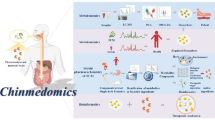Abstract
Traditional Chinese medicine (TCM) is one of the rarely existing ancient traditional medicines that hold systematic theories as well as preventative and therapeutic methods for diseases in practice. From the 1950s, such research methods as mathematics, statistics, and data mining (DM) have been gradually introduced to TCM studies, making it more scientific. Meanwhile, the distinct features of TCM theories and diagnostic-model have constantly challenged the methodology of statistics. This paper introduces the following scientific features of traditional Chinese therapeutics: 1) its goal is to balance the functions and conditions of human body; 2) it emphasizes on holism and individualization; 3) it stresses the longitudinal regulation and evaluation mode, which is a circle of syndrome diagnosis, treatment and evaluation; 4) the interventions of TCM are abundant, compound and natural; and 5) humanistic thought is everywhere. Some statistical problems are raised based on these features. First, complex statistical methods that can analyze subjective indexes and latent variables, multidimensional and multistage data, non-equilibrium designed studies, and longitudinal data are required. Second, comprehensive evaluation on multiple-target mechanism has been brought in by combination treatment. Third, there is a need to analyze how humanity and related cultural factors may influence the effect of interventions. Thus, promoting implemented studies of statistics as well as carrying out the TCM scientific propositions have become the common expectations of both TCM and modern medicine.
Similar content being viewed by others
References
Lu AP, Ding XR, Chen KJ. Current situation and progress in integrative medicine in China. Chin J Integr Med 2008; 14(3): 234–240
Gong YB, Ni Q, Wang YY. Modern methodology on study of TCM syndrome manifestation (II)—quantification and mathematical statistics of TCM syndrome manifestation. J Beijing Univ Tradit Chin Med (Beijing Zhong Yi Yao Da Xue Xue Bao) 2007; 30(1): 5–8 (in Chinese)
Guo L, Wang XW, Wang YY, Cheng YY, Zhang ZB, Zhang JL. On complexity of syndromes from view of high dimensions and high ranks. China J Tradit Chin Med Pharm (Zhonghua Zhong Yi Yao Za Zhi) 2006; 21(2): 76–78 (in Chinese)
Wang YY, Zhang QM, Zhao YJ. Understanding and explanation on the individual diagnosis and treatment of Chinese medicine. Glob Tradit Chin Med (Huan Qiu Zhong Yi Yao) 2009; 2(3): 161–163 (in Chinese)
Qing XM, Fang YG, Liu BY, Wang YY. Pragmatic randomized controlled trials and its methodological features. J Beijing Univ Tradit Chin Med (Beijing Zhong Yi Yao Da Xue Xue Bao) 2008; 31(1): 14–18 (in Chinese)
Xie YM, Zhi YJ, Wang YY. Exploration on innovative clinical effect evaluation methods for TCM—clinical effect evaluation methods for compound interventions. J Tradit Chin Med (Zhong Yi Za Zhi) 2008; 49(5): 395–397 (in Chinese)
Hu JQ, Wang J. Analysis on center effect in correlation between the scores of Qi-Yin deficiency syndrome and blood sugar level in patients with diabetes. Tradit Chin Drug Res Clin Pharm (Zhong Yao Xin Yao Yu Lin Chuang Yao Li) 2006; 17(2): 150–154 (in Chinese)
Hu JQ, Wang J, Liu P, Yi DH, Wu XZ. Analysis on the central effect of Qi-Yin deficiency syndrome scoring in clinical trials of diabetes. Tradit Chin Drug Res Clin Pharm (Zhong Yao Xin Yao Yu Lin Chuang Yao Li) 2006; 17(5): 370–373 (in Chinese)
Adamson J, Cockayne S, Puffer S, Torgerson DJ. Review of randomised trials using the post-randomised consent (Zelen’s) design. Contemp Clin Trials 2006; 27(4): 305–319
Author information
Authors and Affiliations
Corresponding author
Rights and permissions
About this article
Cite this article
Hu, J., Qiao, J., Kang, D. et al. Analysis on the distinguishing features of traditional Chinese therapeutics and related statistical issues. Front. Med. 5, 203–207 (2011). https://doi.org/10.1007/s11684-011-0138-6
Received:
Accepted:
Published:
Issue Date:
DOI: https://doi.org/10.1007/s11684-011-0138-6



